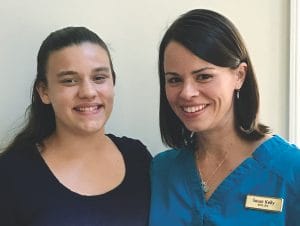 Photo: Luis Mora
Photo: Luis Mora Hospitals often lag in food allergy awareness and sometimes dangerous food mistakes are made. Fortunately, some forward-thinkers are getting change on the menu.
RACHEL Orenstein Packer and her family were just wrapping up an enjoyable visit to New York City when her 11-year-old Ari suddenly began suffering anaphylaxis after eating an olive, which she believes had either an almond inside or nut contamination. Ari is allergic to tree nuts, peanuts and eggs, and they rushed him to the hospital in Queens. He was treated and admitted for observation overnight.
When breakfast arrived the next morning, Packer was shocked: “I noticed there was an unwrapped bagel, and a big side of peanut butter,” she recounts of the food she swiftly took away. She’s incredulous that her son, who’d been admitted to the hospital for an allergic reaction, was then served his allergens on the meal tray.
Jenny Sprague, from Maine, vividly recalls a harrowing experience when her son Jacob was only a year old and in the hospital for kidney surgery. Sprague had gone over his allergens with the dietary staff and when his tray arrived, it all looked fine. Jacob took one good bite of his gluten-free toast, then didn’t want anymore.
Soon Jacob began coughing and Sprague realized crumbs from the bread had fallen on his chest and he was getting hives. She called for the nurse and, before she knew it, the room was filled with nurses and doctors.
Jacob’s symptoms quickly resolved after a nurse gave him epinephrine, and the kitchen manager was called up. It turns out there had been a recent change of suppliers, and the new gluten-free bread contained egg, one of Jacob’s allergens. “She was very apologetic,” recalls Sprague, who is the founder of the Food Allergy Bloggers Conference. But from then on, the mom, who was in the hospital on many occasions for Jacob’s health issues, brought in their own food and left items in the fridge at the nurse’s station, labeled with his name. This has proved an effective strategy for the boy, who’s now 8 years old.
 Jenny Sprague with son Jacob: she now makes and brings his food, to avoid any safe dining issues.
Jenny Sprague with son Jacob: she now makes and brings his food, to avoid any safe dining issues. In Ari’s situation, Packer immediately told the hospital floor manager, who was understandably horrified. “Clearly, there was a miscommunication,” says the mom of two, although she never did learn exactly how the mistake happened.
“You would think of all the places in the world that would understand the importance of food allergies and cross-contamination, it would be a hospital,” says Dennis Korn* of Virginia. Yet he too found it a struggle to get safe food in the hospital for his son in the summer of 2016.
The child has two types of food allergies: eosinophilic esophagitis (EOE) as well as IgE-mediated allergies to dairy, wheat, eggs, soy and peanuts. At the time, Korn’s son was 1 1/2 years old and only able to eat four foods. Because his diet was so restricted, the child was on an elemental diet and getting nutrition through an IV port, which had become infected.
At one point during the boy’s two-week hospital stay to treat the port and blood infection, the Korns decided to order him cantaloupe, a food on his safe list. Instead, honeydew melon arrived. Then they tried asking for steamed carrots, but these were served with corn mixed in, something their son is not allowed to eat. “It was a matter of not paying attention to cross-contamination and not knowing what they were serving,” says the father.
Korn spoke to the staff at the Fairfax, Virginia hospital, including the head of dining services, about their difficulties in getting their son safe food. Their response: “We’re trying.”
Hospitals a Frequent Problem
 Rachel Orenstein Packer with son Ari: 'clearly there was miscommunication.'
Rachel Orenstein Packer with son Ari: 'clearly there was miscommunication.' While, as Korn says, you would think that a hospital would be one place you could count on food being safe for a medically restricted diet, the reality is that many hospitals are lagging behind when it comes to food allergy safety and awareness. Betsy Craig, who has trained professionals at dozens of hospitals in the United States with AllerTrain, a food allergy and gluten-free training course for food-service professionals, says the subject of hospital care comes up frequently.
“It’s probably the biggest area of total disbelief that I hear about from parents at conferences or that I read about on blogs and Facebook, with people saying, “My child went to the hospital for an operation, and I’m the one that had to feed him for four days!’ It’s a nightmare because they’re captive in order to get better for some medical condition and, while there, they suffer the humiliation and the frustration of not getting proper dining care.”
Craig thinks one of the problems with hospitals is that staff are already dealing with so many types of dietary needs – for example, diets for diabetic patients or low-sodium regimens – that the food allergy piece often simply gets lost.
Hospitals are complex organizations, points out Dr. Jeffrey Brady, director of the Center for Quality Improvement and Patient Safety at the Agency for Healthcare Research and Quality (AHRQ). “Care is delivered by multiple people, it often depends on information moving correctly from individuals,” he says.
It’s true that major hospitals are huge institutions, with myriad departments, duty nurse shift changes, with food prepared in large kitchens, by numerous workers who handle a large volume of individual patient food specifications. Still, some big operations – Walt Disney World is a good example – have made food allergies a priority and manage them well with highly structured systems.
Hospital Allergy Issues: Not on Radar
 Photo: Luis Mora
Photo: Luis Mora Despite the rapid increase in food allergies in recent years, the issue of food safety in hospitals for people with allergies doesn’t appear to be on the radar for some key organizations. The American Hospital Association – which declined to provide an expert for this article – did make one recommendation, back in 2008, to implement red as a standardized wristband color for allergies in hospitals. However, that was just a recommendation, and not all hospitals have adopted the standardized wristband colors, including the one signifying allergies.
Brady of AHRQ, an agency within the U.S. Department of Health and Human Services, admits it hasn’t been top of mind for his agency either. “I’ll be honest –we have many patient safety issues that we’re tackling, and this is not one that we’ve focused on specifically,” he says.
While Craig says that her food-service training can be modified to work for hospitals, there is no widely used, standardized training that specifically addresses the unique aspects of a hospital, from identifying patients with allergies to kitchen practices and making sure that the right tray gets up to the right patient.
The better news is that some individual hospitals are adapting to the new allergy reality and developing processes to greatly reduce food-service errors. But parents and patients need to be mindful – food allergy and celiac awareness are still far from uniform across U.S. hospitals.
Systems are Critical to Getting It Right
When patient safety analyst Susan Wallace from the Pennsylvania Patient Safety Authority decided to investigate dietary issues at hospitals in her state, she found evidence of a problem with allergy awareness. In her review of 285 dietary events that occurred at Pennsylvania hospitals from 2009 to 2014, the majority, 63.5 percent, involved a patient getting an item on a tray that they were allergic to.
When it comes to patient safety, she says people often think of medical events, like giving the wrong medication or doing the wrong procedure. “But there are other types of events, such as dietary events, which could cause harm just as easily,” says Wallace. She adds that, “sometimes because of the process, hospitals aren’t really aware or are somehow overlooking that a person has a [food] allergy.”
To find out more about what could lead to a patient being delivered the wrong food, Wallace turned to individual hospitals in her state. She found that mistakes can happen at a number of steps along the way: from admission, where the allergy doesn’t get noted properly, to the medical staff not properly checking medical history when placing a diet order, to nursing staff not matching the patient’s name on the wristband to the name on the tray before putting the tray in a room, or the food services department not preparing a safe meal in the kitchen, even when food allergies were noted.
In one instance in Wallace’s report, a patient with a fish allergy came into the emergency room and the allergy was recorded there, but that information was not transferred and the patient was served a dish containing fish after admission to the hospital. The person suffered an anaphylactic reaction.
In another incident involving a fish allergy, the allergy was listed in the medical record, but as a drug allergy rather than a food allergy. That patient, who was not as alert as normal because of a treatment, did not realize he was eating fish and immediately began to react. Even with medication, he need to be transferred to the intensive care unit for intubation. “There are so many instances where something could go wrong,” says Wallace.
Yet there are hospitals that are rising to the food allergy challenge, and employing technology to design tools and systems to keep allergic patients safe.
 Dietitian Kelsey Bierlein: solutions in technology.
Dietitian Kelsey Bierlein: solutions in technology. Kelsey Bierlein is the informatics dietitian at Seattle Children’s Hospital, and her job includes maintaining the diet software that houses all the kitchen’s food items, recipes and menus. Her hospital has recently converted to the ‘room service’ model, which allows patients to order what they want, when they want it, provided it’s in line with their diet order from the medical staff.
On her end, Bierlein enters information for all the food items – whether fresh or packaged – into the database, including all ingredient info. From there, recipes are built, and if there is an allergen listed, a particular recipe is flagged for that allergy. (For example, a pasta recipe might be flagged for wheat allergy).
The patient’s parent will look at the menu and choose what the child wants to eat, but will not be able to order anything that’s flagged for that patient’s allergens. “The call center staff won’t be able to order it for them. It’s a hard stop,” says Bierlein.
But technology can be rigid. “With the software it’s really black or white, it either is or it isn’t an allergy,” says Bierlein. The hospital errs on the safe side with allergens and flags everything that has a ‘may contain’ warning as actually containing that allergen.
As not all allergic patients are rigorous about avoiding precautionary warnings, or others may have a sensitivity such as lactose intolerance as opposed to severe dairy allergy, patients sometimes object that they are not able to order foods they eat at home.
At St. Vincent Evansville in Indiana, lead dietitian Kelli Robertson describes her hospital’s system to identify patients with life-threatening allergies. When a nurse admits a patient to the medical center and makes note of any allergies, she has the ability to designate whether these are ‘life-threatening’. “That information goes directly to the food services department,” says Robertson.
Patients with life-threatening allergies will order from a special menu. “It’s normally things that are very basic like whole fruits, plain vegetables, plain chicken breast, plain hamburger, where we use 100 percent beef,” the dietitian explains. By using plain, whole foods, they are minimizing the risk of cross-contact, she says.
If a patient does want something that’s not on the menu, the family can contact the call center, who will speak to the dietitian to come up with a solution. “For one pediatric patient, we were able to take a clean skillet with some olive oil and sauté some potatoes for him. It wasn’t the same as Tater Tots or French fries, but it was an alternative.”
Hospitals and Allergies: Kitchen Concerns
 Susan Kelly, who's a nurse, with Elaine. The girl had six days of bland food because of her EoE allergy.
Susan Kelly, who's a nurse, with Elaine. The girl had six days of bland food because of her EoE allergy. Identifying people with allergies and offering them options is one thing, but it doesn’t mean much if the kitchen staff doesn’t fully understand ingredients and how to limit allergy errors.
Susan Kelly’s 13-year-old daughter, Elaine, was in the hospital from complications from the flu this past January when she ordered scrambled eggs. She has an EoE allergy, and avoids dairy and gluten. Kelly informed staff of her daughter’s dietary restrictions, and they provided her with a dairy-free, gluten-free menu. Elaine chose scrambled eggs. But when they arrived, an astute nurse stopped her from eating, saying she believed they were made with butter.
A call to the kitchen confirmed it. No longer trusting of the more complex items on the menu, Elaine stuck with plainer foods. “Six days of hard boiled eggs, rice cakes and boiled chicken is frustrating for a young teen,” says her mother.
Kelly, a registered nurse who hasn’t worked in the hospital setting in more than 10 years, notes how powerless you can feel as a patient when the food arrives in front of you. “Nothing is labeled, you’re just given this tray. You can’t do your regular safety checks.” she says.
As the executive chef for Children’s Hospital Colorado, JP Krause is well aware of the challenges that food allergies present in a hospital kitchen. Krause says his team will see at least three to five, but sometimes more, orders an hour come through his kitchen for patients with allergies. “With allergies, it’s trying to control what you can control, and understanding what you can’t control. And being very open and honest with customers,” he says.
Similar to Seattle Children’s, kitchen staff at Children’s Hospital Colorado rely on a computer system that automatically prevents a patient from ordering food if it contains an allergen. When the order for a safe food is placed, the ticket will show up with instructions from the call center staff indicating that the patient has a food allergy.
Technology, Color Cues
“The first thing [the cooks] do is wash their hands and change their gloves,” says Krause. He explains that the items from that order are cooked in a clean, separate pan, rather than on the flat top or grill. If the cook touches anything in between, he will wash his hands again and put on new gloves. Clean utensils are used to plate the dish.
Aware that not all allergies are the same – for example, a dish with cheese is safe for someone with a peanut allergy but not a patient with a dairy allergy – the kitchen is set up with an allergy station, which includes six purple-colored cutting boards and six knives. Every time one set is used, it’s cleaned twice in the industrial dishwasher, as a precaution.
Krause also touts his kitchen’s latest addition: a custom-made deep fryer. “There are three tanks, and each has its own filtration system. The first one is a gluten-free fryer, so we can make gluten-free French fries. The next one is used for any shellfish or fish, then the last one is a regular-diet fryer.”
Back at Seattle Children’s, Bierlein is also excited about recent changes to the hospital kitchen that make it easier to accommodate food allergies. The recent transition from a system in which the staff cooks large batches of one or two items per meal to the room-service model is far more conducive to preparing meals with whole foods and fresh ingredients.
“In the old model we made a lot more packaged foods. We did not have enough space to prep food; for example, to wash, dice, slice and make our own sauces,” she explains. “With the design, we have a whole area for all of that now. It’s a lot easier to manage because when you’re making things from whole foods, you know exactly what’s going into it. You don’t have all of the hidden potential allergens.”
Bierlein says they also limit the amount of products with peanuts and tree nuts in the kitchen and, for things like rolling out pizza dough, a gluten-free flour is used to prevent wheat flour from flying around the kitchen.
One major challenge both Bierlein and Krause bring up – suppliers don’t usually alert the hospitals to ingredient changes or out-of-stock items in advance, which can leave cooks and dietitians scrambling to find alternatives. This is an issue present in all aspects of food service, notes Craig. “You have to train managers and staff on how to check labels every time.”
Once that specially prepared safe meal is ready, it needs to make its way up to the right patient. That’s where things like visual cues and good communication between departments become critical.
 Chef JP Krause: color-coding for allergies.
Chef JP Krause: color-coding for allergies. At St. Vincent Evansville, Natalie Wilzbacher, who is the nursing director of pediatrics and pediatric ICU, says identification of people with food allergies is a priority when they admit patients to the hospital. The information goes right on the header of their electronic medical record, along with name, weight and date of birth.
That hospital has adopted the AHA’s ‘red for allergy’ wristband recommendation, and also uses a red sign on the door to alert dietary staff that they should check in with the nurses’ station before entering with food in order to double-check that a safe meal is on the tray.
Krause says he also uses visual cues – for example, there are some patients in the hospital who are being treated with eating disorders and whose diet orders include peanuts – those trays are red, to alert everybody who sees them that they contain the common food allergens. As well, there is a differently colored ticket printed for allergy orders, which signals to the allergic patient that yes, this tray of food was prepared in a safe way.
In huge, busy institutions, mistakes still can happen. Bierlein hasn’t experienced any serious safety events with food at Seattle Children’s, but there have been instances where someone got something on their tray they shouldn’t have.
She says her department relies on the hospital’s e-feedback system, where nurses or staff can enter information about what occurred, to “provide a chance to circle back and look at the process and find areas where you can make improvements.”
Opportunity to Improve
Brady agrees these “near-misses” are crucial to improving patient safety. “If the tray made it that far with a food allergen on it, then that should really get our attention, even if nobody was harmed. Then the next important step is – what’s done about it. Those are opportunities that we absolutely don’t want to miss in health care and in patient safety”
While institutions can be slow to change, Craig is hopeful there will be a ripple effect so that as more hospitals adopt good food allergy protocols, other hospitals will follow suit. She believes that through social media pressure especially, consumers will instigate the shift from food allergies as an afterthought to being fully integrated into a hospital’s procedures.
She also notes that, unlike a decade ago, hospitals quite routinely send out patient surveys to see how your hospital experience was. “That’s all part of consumer feedback that ultimately will work positively for people with food allergies.”
*Family name was changed for privacy.
Related Reading:
Food Allergies and Hospitals: How to Be a Proactive Patient
Hospital Breakfast Linked to Allergic Teen’s Death
18 Things To Know About Food Allergy Reactions





